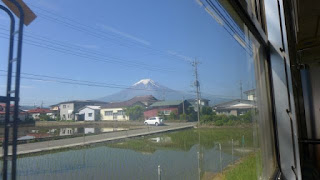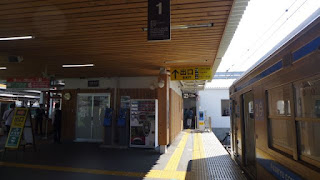Matsumoto
Matsumoto
29 May 2016
Rise and shine. It's a sunny day today, perfect weather to view Mt Fuji. Unfortunately, we would be leaving Kawaguchiko today, travelling to Matsumoto. We have already pre booked our hotel at Matsumoto for today and the next day, so it was not possible to make changes as we would be charged for the first night stay already.
We started our journey early in the morning to catch the local train (Fujikyu line) to Otsuki at 7.48am, and reaching there at 8.45am. Then we would travel onwards by local train (Chuo line), changing to Shinonoi line at Kofu station to Matsumoto. The Fujikyu line local train costs JPY 1140, and the JR local train from Otsuki to Matsumoto costs JPY 2590. We could see Mt Fuji clearly from our train along the Fujikyu line. From Otsuki to Matsumoto, the view was mostly comprised of paddy fields and villages. We arrived at Matsumoto around 1pm. From Matsumoto, we walked to our hotel - Matsumoto Tourist for about 10 mins (JPY 5230 per room per night) and dropped our backpacks first.
We then proceeded to walk for another 10 minutes to Matsumoto castle. Entrance fee costs JPY 610, which includes entry to the Matsumoto museum as well. The Fukashi castle was built at the beginning of the Eisho era, in the civil war period. Sadayoshi Ogasawara captured the Fukashi castle and changed the name to Matsumoto castle. On the second floor is the rooms for warriors to assemble, and now also has exhibits of armoury. The third floor is dark without windows and cannot be seen from the outside. The warriors stayed here during wartime. The fourth floor is the private residence where the lord stayed during emergencies. The fifth floor was used for tactical meetings of military officers during wartime. The sixth and the highest floor was used as a watchtower for enemies during wartime. During time of peace, the moon observatory was included on the first floor. There are 25 openings for archers and firearms on the thick walls, and stone drops openings on the first floor to prevent enemies from climbing up the stone walls. The castle is also unique with its wooden interiors of pillars (the maruta bashira bolt pillars are 400 years old), flooring and staircases. Information are extracted from the Matsumoto castle information pamphlet.The administration of Matsumoto castle are currently applying for Unesco World Heritage site status. It is already a National Treasure of Japan.
From Matsumoto castle, we went to the Matsumoto museum next door which has some exhibits of the old days of Matsumoto ans samurai warrior armour. Then, we walked back to our hotel, stopping by a souvenir shop located very near to the castle, and then to Nawate-dori street along the Metoba-gawa river, a frog themed shopping street with antique and artisan shops and selling their wares. There are also many water wells with cool and drinkable water along the streets at Matsumoto. The water from the tap in our hotel bathroom is also drinkable. Another trademark of Matsumoto is the temari threadballs weaved from yarn. The tradition started 200 years ago, when a lady from the Matsumoto Clan nobility made the first temari.The image of the temari threadballcan be seen on the manhole covers around Matsumoto.
29 May 2016
Rise and shine. It's a sunny day today, perfect weather to view Mt Fuji. Unfortunately, we would be leaving Kawaguchiko today, travelling to Matsumoto. We have already pre booked our hotel at Matsumoto for today and the next day, so it was not possible to make changes as we would be charged for the first night stay already.
 |
| Mt Fuji from Kawaguchiko station |
 |
| Mt Fuji from Sawa Hotel road |
We started our journey early in the morning to catch the local train (Fujikyu line) to Otsuki at 7.48am, and reaching there at 8.45am. Then we would travel onwards by local train (Chuo line), changing to Shinonoi line at Kofu station to Matsumoto. The Fujikyu line local train costs JPY 1140, and the JR local train from Otsuki to Matsumoto costs JPY 2590. We could see Mt Fuji clearly from our train along the Fujikyu line. From Otsuki to Matsumoto, the view was mostly comprised of paddy fields and villages. We arrived at Matsumoto around 1pm. From Matsumoto, we walked to our hotel - Matsumoto Tourist for about 10 mins (JPY 5230 per room per night) and dropped our backpacks first.
 |
| ticket to Otsuki |
 |
| Fujikyu commuter train |
 |
| inside the Fujikyu commuter train |
 |
| Mt Fuji from Fujikyu commuter train |
 |
| Mt Fuji from Fujikyu commuter train |
 |
| Mt Fuji from Fujikyu commuter train |
 |
| train with cute Mt Fuji cartoon |
 |
| train with cute Mt Fuji cartoon |
 |
| Otsuki station |
 |
| Mt Fuji on manhole cover at Otsuki |
 |
| ticket from Otsuki to Matsumoto |
 |
| take the Chuo line to Kofu |
 |
| inside local train Chuo line to Kofu |
 |
| village view from Otsuki to Kofu |
 |
| paddy field view from Otsuki to Kofu |
 |
| inside local train Shinonoi line from Kofu to Matsumoto |
 |
| Matsumoto train station |
We then proceeded to walk for another 10 minutes to Matsumoto castle. Entrance fee costs JPY 610, which includes entry to the Matsumoto museum as well. The Fukashi castle was built at the beginning of the Eisho era, in the civil war period. Sadayoshi Ogasawara captured the Fukashi castle and changed the name to Matsumoto castle. On the second floor is the rooms for warriors to assemble, and now also has exhibits of armoury. The third floor is dark without windows and cannot be seen from the outside. The warriors stayed here during wartime. The fourth floor is the private residence where the lord stayed during emergencies. The fifth floor was used for tactical meetings of military officers during wartime. The sixth and the highest floor was used as a watchtower for enemies during wartime. During time of peace, the moon observatory was included on the first floor. There are 25 openings for archers and firearms on the thick walls, and stone drops openings on the first floor to prevent enemies from climbing up the stone walls. The castle is also unique with its wooden interiors of pillars (the maruta bashira bolt pillars are 400 years old), flooring and staircases. Information are extracted from the Matsumoto castle information pamphlet.The administration of Matsumoto castle are currently applying for Unesco World Heritage site status. It is already a National Treasure of Japan.
 |
| moat around Matsumoto castle |
 |
| Matsumoto castle |
 |
| wooden pillars |
 |
| wooden interior |
 |
| beneath the top floor roof |
 |
| wooden staircase |
 |
| view from top floor |
 |
| view of the moat from top floor |
From Matsumoto castle, we went to the Matsumoto museum next door which has some exhibits of the old days of Matsumoto ans samurai warrior armour. Then, we walked back to our hotel, stopping by a souvenir shop located very near to the castle, and then to Nawate-dori street along the Metoba-gawa river, a frog themed shopping street with antique and artisan shops and selling their wares. There are also many water wells with cool and drinkable water along the streets at Matsumoto. The water from the tap in our hotel bathroom is also drinkable. Another trademark of Matsumoto is the temari threadballs weaved from yarn. The tradition started 200 years ago, when a lady from the Matsumoto Clan nobility made the first temari.The image of the temari threadballcan be seen on the manhole covers around Matsumoto.
 |
| Japanese armory in the museum |
 |
| interior of old village exhibit in the museum |
 |
| frog themed Nawate Dori street |
 |
| frog themed Nawate Dori street |
 |
| shops at Nawate street |
 |
| shops at Nawate street |
 |
| frog shrine |
 |
| Yohashira shrine near Nawate Dori street |
 |
| Metoba-gawa river at Nawate Dori street |
 |
| unique old style bookstore in the middle |
 |
| natural water wells along the streets |
 |
| the tap water in our bathroom is good to drink |
 |
| Matsumoto Tourist hotel |
 |
| our room |
 |
| comic library at our hotel (in Japanese only) |
 |
| coin operated laundry at hotel |
 |
| Temari manhole cover |
Labels: Travelogue


0 Comments:
Post a Comment
<< Home